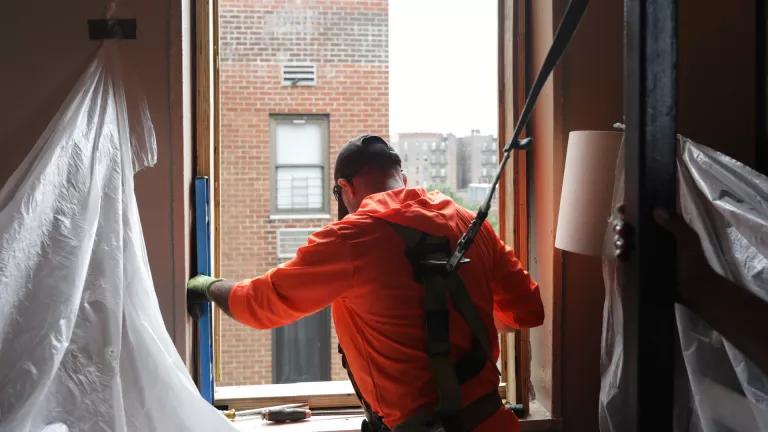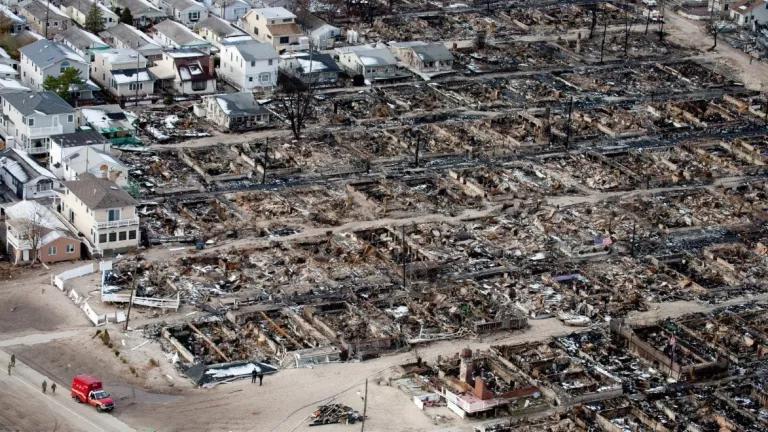NY and NJ: Centers of Action on Low Carbon Concrete Buying
This has been a breakout year for policies aimed at reducing embodied carbon in the built environment, with Buy Clean and other public procurement initiatives emerging as among the most critical platforms for decarbonizing heavy industry.

This is a guest blog by Chris Neidl. Chris is a policy consultant to NRDC's cement decarbonization team and lead author of NRDC's Design Guide to State and Local Low-Carbon Concrete Procurement.
The post has been updated to reflect passage of New Jersey's low carbon concrete procurement legislation by the state Assembly on December 15, 2022.
As the world’s most common construction material -- and one of the most emissions intensive to produce -- concrete will be a major focal point for intervention and change in the wake of these developments.
Perhaps the most momentous and far-reaching policy change occurred last month with the announcement from the Biden Administration’s Buy Clean Task Force that the federal government, supported by $5 billion in funding from the Inflation Reduction Act, will now prioritize the use of low carbon concrete, steel, asphalt, and flat glass in nearly all public construction projects. However, this major federal milestone is far from isolated. Cities and states across the country have paved the way for clean purchasing policies.
In 2022, New York State and City, and neighboring New Jersey, have emerged as the most prolific centers of activity in this area, producing among the most innovative and influential low carbon procurement proposals and policies in the country. Just days after the Federal Buy Clean announcement, New York Governor Kathy Hochul and New York City Mayor Eric Adams each signed their own separate, but highly aligned, executive orders for climate-based procurement. State Executive Order 22 (EO 22) includes a range of procurement commitments and guidelines across a number of climate and environmental priorities, including embodied carbon reduction in new construction, and New York City’s Clean Construction Executive Order 23 (EO 23) more narrowly targets embodied and operational emissions in locally procured concrete.
Both orders build upon and draw from other policy advancements implemented earlier in the year. Last January, Governor Hochul signed into law the Low Embodied Carbon Concrete Leadership Act (LECCLA), which, enacted, convenes an agency and industry stakeholder group to design a system for state agencies to award contracts based not just on price, but also climate performance. Critically, this expert panel is tasked with recommending performance incentives and other policy interventions aimed at accelerating innovation in the sector, and not simply rewarding incremental improvements to the way concrete is made today.
EO 22 builds on elements of LECCLA, including requiring bid-stage environmental product declarations (EPDs) for contractors, as well as an explicit declaration that accelerating innovation will be an objective of climate-aligned procurement. Unfortunately, the EO missed an opportunity for greater impact by excluding specific incentives for contractors, as well as binding targets and timelines for emissions reductions in concrete and other building materials. However, what’s put forth sets a foundation for a more ambitious and comprehensive approach, and opens the door for successor policies and amendments.
In April, the State fully approved its first Lower Carbon Concrete specification, which directly applies to concrete purchased by state agencies for building and roadway construction. This new specification is also certain to influence the purchasing standards of local governments throughout the state that commonly defer to state specification guidelines. New York City’s EO 23 directs the city to develop and require low carbon concrete specifications, borrowing significantly from the state version that preceded it.
At the center of the new state specification is a mandatory reduction in the amount of Portland cement used in construction. Like flour in bread, cement is the most important ingredient in concrete – essentially the glue that holds it together. However cement-making is highly energy and emissions-intensive, which makes cement the source of most of the emissions associated with concrete.
When states and other buyers are looking to reduce climate emissions associated with the concrete being used for their construction project, an essential focus area for intervention is setting standards for and/or otherwise encouraging reductions in the amount of cement mixed in—for example, by reducing the overspecification of cement in concrete mixes and encouraging the use of supplementary cementitious materials like ground glass pozzolans to partially displace cement in concrete mixes.
Another notable element of the specification is the level of discretion that the new guidelines assign to licensed ‘design professionals' (i.e. professional engineers and architects) tasked with approving and assuming liability for material selection in concrete mixes used. This implicitly opens the door for a shift from prescriptive to performance-based specification standards -- a change widely considered by industry and environmental advocates alike as an essential precondition for innovation in the concrete sector and acceptance of new mix designs.
Meanwhile, next door in New Jersey a more robust version of New York’s LECCLA legislation has passed both chambers of the state legislature with considerable bi-partisan support, and backed by a broad coalition that includes key industry stakeholders, and is now awaiting Governor Murphy's signature. This bill goes further by incorporating tax credit incentives for concrete producers who overperform state-established embodied carbon standards. If signed into law, it would be the first such incentive program in the United States. Notably, elements of the New York and New Jersey LECCLA legislation have informed similar bills introduced in other states, including Massachusetts, Virginia, and Illinois.
The impressive policy trajectories of both states owe much to the pioneering program commitments put into effect earlier by the Port Authority of New York and New Jersey, a bi-state agency that oversees a considerable transportation infrastructure portfolio, including major airports. The Authority’s Clean Construction Program, launched in April 2021, included a Low Carbon Concrete Program as a core initiative. The latter includes both a low carbon procurement standard – focused on cement reduction – that bears much in common with the New York State specification introduced a year later. It also established an ongoing research and testing program that aims to continuously identify, verify, and approve new lower carbon concrete mixes.
In April of this year NRDC published A Design Guide to Low Carbon Concrete Procurement for State and Local Governments which defines specific policy recommendations drawn from existing programs and proposals in jurisdictions throughout the United States. Many of the New York/New Jersey policy achievements described above align with the specific model policy set that is described in the guide, reflecting the leadership role of these states in this critical area of climate policy. Moving forward, there are several new openings the state and city should seize in order to create genuine model policies that other states and jurisdictions can replicate:
- Establishing preferences for low carbon bidder. New requirements can and should be coupled with a bid preference or other incentive that gives suppliers offering concrete with verifiably superior climate performance a selection advantage within certain cost parameters.
- Establishing a maximum carbon intensity ceiling for commonly used construction materials in public projects. New York State and New York City’s Lower Carbon Concrete Specifications can serve as the minimum standard for bidding in for public works projects.
- Awarding performance-based bonuses or other incentives for high performers. Bidders or hired contractors who provide materials that significantly surpass that minimum standard should be financially rewarded.
- Expediting evaluation for low carbon concrete materials. EO 22 contains a strong rationale for accelerated material testing, review, and acceptance rules for low carbon concrete innovations by state DOTs. Accelerated review and testing is important because under normal conditions these state-administered processes can be lengthy and characterized by high levels of uncertainty for applicants, slowing market transformation.
One important lesson from recent experiences in both New York and New Jersey, taken as a whole, is that there are multiple pathways to enacting high-impact procurement policies. In addition to legislative action, executive orders and other executive actions at the agency or gubernatorial level can also deliver or create necessary support conditions by which a suite of optimal policies can be realized. Legislative and executive actions should thus be seen as dual pathways to ultimately deliver the most ambitious state and local procurement policies.



